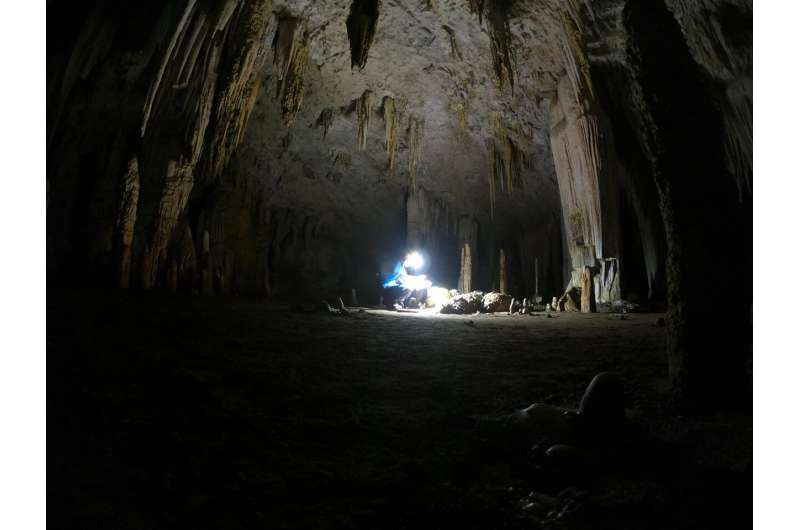This article has been reviewed according to Science X's editorial process and policies. Editors have highlighted the following attributes while ensuring the content's credibility:
fact-checked
peer-reviewed publication
trusted source
proofread
Scientists highlight discrepancies in regional climate models

Up to now, the results of climate simulations have sometimes contradicted the analysis of climate traces from the past. A team led by the physicist Thomas Laepple from the Alfred Wegener Institute in Potsdam and the climatologist Kira Rehfeld from the University of Tübingen has therefore brought together experts in climate models and climate tracks to clarify how the discrepancies come about.
The surprising result has now been published in the journal Nature Geoscience: in a way, both sides are right. Climate models correctly simulate global temperature trends, but often underestimate the strength of regional climate fluctuations, especially over the course of decades to centuries.
In order to understand the causes and consequences of climate fluctuations, researchers examine climate archives, such as trees, lakes and marine sediments or even ice.
Over the course of centuries and millennia, the climate has continuously varied, leaving behind traces. Understanding natural climate changes enables better assessments of what lies ahead with man-made climate change. Anticipating how humankind can prepare for the consequences of increasing global warming is of paramount importance.
"We will feel the effects of climate change primarily regionally," says physicist Prof. Dr. Thomas Laepple of the Alfred Wegener Institute Helmholtz Center for Polar and Marine Research (AWI) in Potsdam. "In some regions, droughts will become more frequent, potentially leading to crop failures over extended periods. Elsewhere, we will witness more powerful hurricanes."
The problem is that global climate models are often unable to represent regional variations in detail when projecting several centuries into the future. While they are good at accurately simulating the global warming trend, they still lack the ability to accurately simulate local conditions. This makes it difficult to plan and implement concrete measures to adapt to the climate—for example, in agriculture to switch at the right time to crops that can tolerate higher temperatures.
Thomas Laepple and his colleagues already pointed out the problem of local predictive power about 10 years ago. In an analysis of the climate evolution over the last 7,000 years, they had then uncovered a striking discrepancy between global climate simulations on the one hand and local analysis of climate traces from centuries- or even millennia-old marine sediments, tree rings, pollen or corals.
These indicators shed light on past temperatures in specific regions of the Earth. On a regional scale, climate simulations and sediment sample analyses differed in their temperature estimations, sometimes by a factor of 50, leading to controversial discussions among experts.
"At the time, we were faced with a conundrum," recalls Thomas Laepple. "We couldn't say with certainty whether the climate models were incorrect in the selected examples or whether the temperature data derived from the sediment samples were based on faulty assumptions."
Subsequently, Thomas Laepple and climatologist Kira Rehfeld from the University of Tübingen successfully drew attention to this problem. Among other initiatives, workshops brought together experts in climate models and those who evaluate climate traces. Laepple and Rehfeld also collaborated with colleagues to establish the international working group CVAS (Climate Variability Across Scales), which delved into the discrepancy between regional and global scales in greater detail.
Now, in collaboration with Kira Rehfeld and other colleagues, a review article has been published in the journal Nature Geoscience, highlighting these discrepancies. Co-authors also include students and workshop participants who contributed to the study through literature research and scientific illustrations. The most significant finding: in a sense, both sides are correct—the climate modeling experts and those who evaluate the climate traces.
"We found that climate models are skillful at tracing past global temperature trends," says Thomas Laepple. "However, the longer the time period you examine, the more regional deviations are averaged out. Trends in regional temperature values become overly smoothed."
One reason might be that global climate models do not account for various regional buffering phenomena—such as regional ocean currents that stabilize the climate in coastal regions for many years or even decades, even as the global average temperature changes.
"We are increasingly observing regional climate changes around the world—temperatures, for instance," he notes. "There is a wide range. Some regions may experience a cooling for a few years, while others may see temperatures significantly higher than the global average, and abrupt shifts are also possible. It is crucial to bear this in mind when conducting risk assessments for climate adaptation."
He emphasizes the importance of understanding that several years of cooling in one region does not negate the reality of climate change. "The global trend of warming is unmistakable over decades—even if the climate in individual regions may deviate for a period."
More information: T. Laepple, Regional but not global temperature variability underestimated by climate models at supra-decadal timescales, Nature Geoscience (2023). DOI: 10.1038/s41561-023-01299-9
Journal information: Nature Geoscience
Provided by Alfred Wegener Institute




















